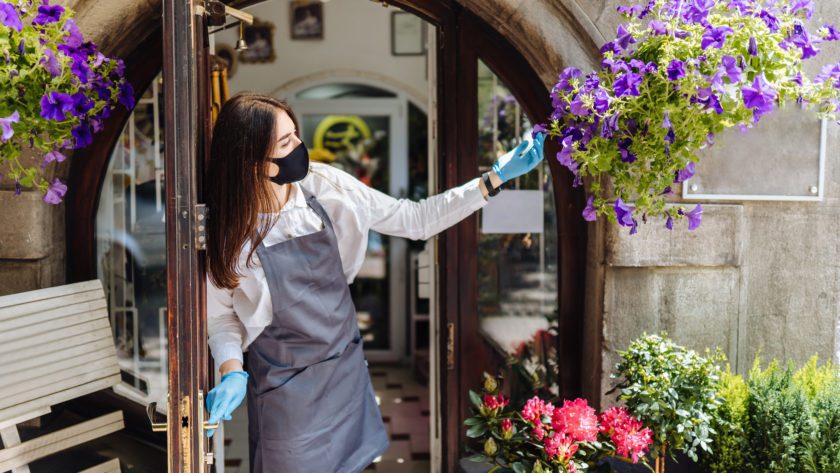Alas! “Higher risk” businesses in various communities are beginning to reopen, but people are wondering whether they should — and how they should — head into the office, eat in restaurants, shop, and visit hair salons. As lockdowns loosen, here are some tips on going out and reducing your risks.
COMMUTING
Commuting options from safest to riskiest:
1. Walk, bike, and drive your own car to work (safest).
2. Take a taxi or use Uber/Lyft.
- Be sure the driver is wearing a mask to trap respiratory droplets when coughing, sneezing or exhaling. The plexiglass shields in taxis provide a barrier of protection.
- Open car windows on both sides of the car to provide cross ventilation and reduce the viral load (number of virus particles per volume of air).
- Handle your own bags. Carry your briefcase or purse on your lap. Don’t put it on the floor.
3. Ride a bus or BART train (riskiest). Public transportation is a petri dish of respiratory pathogens. You’re likely exposed to dozens of potentially infected people vs. just one potentially infected person in a taxi or ride-share. If public transportation is necessary:
- Wear a face mask.
- Be ultra-meticulous about hand hygiene.
- Stand vs sit and bring a strap to hang onto for support.
- Carry hand sanitizer and wipes.
- Don’t touch your face.
- Wash hands with soap and water for 20+ seconds. Rinse thoroughly.
IN THE OFFICE
Some businesses are bringing back their work staff in shifts to allow for social distancing or only bringing back a portion of their employees.
1. Use the stairs instead of elevators. If you must use an elevator:
- Distance yourself from others while in such a small enclosed space.
- Wear a mask and glasses.
- Don’t get on if someone is not wearing a mask.
- Face the wall to avoid direct contact with someone’s breath.
- Don’t touch any surfaces, such as railings and elevator buttons.
2. Consider EVERY surface as contaminated. Don’t touch doorknobs and printer buttons without disinfecting or use a tissue or paper towel. Immediately wash or sanitize your hands. Don’t touch your face.
AT A RESTAURANT
The biggest risk in dining inside a restaurant is not just being around other people in an enclosed space for an extended period of time, but touching potentially contaminated surfaces then touching your mouth.
- Avoid crowds while waiting for tables and don’t congregate around the bar.
- Sanitize your hands before eating.
- Eat outside where there is air flow and particles are dispersed.
- Be wary of all “high touch” surfaces, e.g., salt/pepper shakers, pens and leather holders for the check.
Per a study published in the New England Journal of Medicine in March, the coronavirus can live on cardboard for up to 24 hours and on hard surfaces such as stainless steel and plastic for two to three days.
Restaurants have been provided with re-opening guidelines, such as spacing tables at least six feet apart; providing hand sanitizer; eliminating self-service salad/drink stations and unwrapped straws; using throw-away menus; wrapping sanitized utensils.
IN A RETAIL STORE
Similar to supermarkets, other retailers are quickly adopting similar practices of social distancing, limiting the number of shoppers, and keeping people spaced apart in checkout lines. Safely shopping for clothes and trying them on is a concern when shopping for clothes and retailers are scrambling to come up with a solution.
Per an April 30 retail survey conducted by First Insight, the following said they will NOT feel safe trying on clothes in dressing rooms:
- 65% of women
- 54% of men
- 49% of millennials
- 71% of baby boomers
- Department stores are opening just a few fitting rooms or closing all of them.
- Returned merchandise will be held from 24 to 48 hours.
- UV sanitizing systems are being considered by retailers to clean garments within an hour.
- Some tailors are allowing customers to book fitting rooms or private shopping suites that have been disinfected prior to use.
This is where “window shopping” and eye-catching window displays may become more relevant to the shopper and retailer post-COVID-19. When shoppers see something they like in the window, they text the number displayed.
AT THE HAIR SALON OR BARBER SHOP
Like restaurants, hair salons have been provided with guidelines to follow prior to opening, such as scheduling stylists in shifts, taking temperatures, wearing disposable salon capes, gloves, masks, and waiting outside. The biggest risk is that the hairdresser and customer are in close contact and may be really close for extended periods of time. The hairdresser may have been unknowingly been exposed to an infected person and may be shedding the virus.
If you are immunocompromised, perhaps your local hairstylist might be willing to make a house call and cut your hair outside in the backyard. Hairstylists are also often willing make house calls, especially to senior residential home care facilities.

![]() Fit Tip: There are ways to reduce the risks when going out. You just have to be cautious, wash your hands, and avoid touching your face. For some people at high-risk, it may still be safer to stay home as much as possible.
Fit Tip: There are ways to reduce the risks when going out. You just have to be cautious, wash your hands, and avoid touching your face. For some people at high-risk, it may still be safer to stay home as much as possible.

